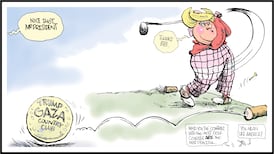There's more to Sadr than meets the eye - the Iraqi cleric has an illustrious family background of resistance to subjugation, writes Sami Ramadani.
Secular as well as Islamic anti-occupation forces in Iraq are now beginning to drop their caution about Moqtada al-Sadr and are openly siding with his resistance forces in Najaf.
The National Foundation Congress, the influential umbrella organisation that represents most religious, nationalist and other secular forces opposed to the US-led occupation, on Saturday issued an eight-point proposal, already approved by Sadr, to peacefully end the crisis in Najaf. This proposal strengthens Sadr's hand and is in essence a call to end the US-led forces' carnage in Najaf and Baghdad and all other areas of Iraq.
But as intense fighting continues around the Imam Ali shrine, where Sadr's fighters have resisted more than two weeks of US bombardment, it's worth taking a closer look at the man himself. There is much more to Sadr than meets the eye.
His full title is Hujjat il-Isalm al-Sayyid Moqtada Muhammad Sadeq al-Sadr, and he is aged 31. Al-Sayyid literally translates to mister, but when conferred by clerics, as in this case, it is public recognition that the man concerned can authentically trace his lineage to the Prophet Muhammad.
Muhammad Sadeq is his father's name. Grand Ayatollah Muhammad Sadeq al-Sadr was murdered in 1999 by Saddam Hussein, because he was building bridges with Sunni clerics and becoming influential among the poor, particularly in the two-million strong poorest district of Baghdad now known as Sadr City.
His uncle, Ayatollah Muhammad Baqir al-Sadr, was an even more politically significant figure: he and his sister Bint-ul-Huda were tortured to death by Saddam's thugs in 1980. The pair had founded a powerful militant movement that was at the forefront of the Islamic wing of the opposition to Saddam's regime. It is reported that Saddam himself shot both of them after their torture.
Sadr often reminds his listeners of this illustrious heritage, including active involvement in the 1920 revolution against British occupation. Like his father, he often wears a white robe on top of his religious garb to indicate that he too is ready to be "a martyr in the cause of liberation and independence".
When the US-led occupation forces sought to capture him "dead or alive" in April, he chose to resist rather than surrender.
No matter how young and politically inexperienced they were told that he was, the militant patriots of Sadr City, Najaf, Basra and beyond began to trust him and saw in him the rightful custodian of the traditions handed down by the rebellious Islamic leaders who chose martyrdom rather than obey tyranny.
Indeed, Saddam's regime finally began to totter, despite the murderous US-led 13 years of sanctions that strengthened him and hurt the people, precisely because this uncompromising will to be free and resist subjugation runs very deep in Iraq.
It is said that Iraq's Shia strictly follow their most senior religious leaders. This might be true of practising Shia in calmer times. But in times of crises this readiness to listen to "wiser" councils evaporates. Grand Ayatollah Sistani was being listened to attentively after the invasion. The number of his portraits on display was rising with every defiant statement.
During the past few weeks, however, those portraits were fast disappearing to be replaced by Sadr's; and those of his father; his uncle; Ayatollah Khomeini; and those of another potent and popular junior, Nasrallah, leader of Hizbullah in Lebanon.
There are now signs that, like Nasrallah in Lebanon, Sadr is learning that he needs to build bridges with Iraq's varied sects, religions, nationalities and secular political trends. After US proconsul Paul Bremer appointed the now defunct Iraqi Governing Council last year, Sadr unilaterally declared the appointment of an alternative government composed solely of his supporters. It went down like a lead balloon.
However, when asked last week about the political and social programme of al-Tayyar al-Sadri's (the Sadri current), one of Sadr's main spokesmen said Sadr opposed the publication of such a detailed programme because it had to evolve from and be agreed at a conference of all Iraq's political forces. Indeed, if the Sadri current is to last the distance, he has to also take on board that the Kurds in Iraqi Kurdistan and Iraqi women, particularly in the cities, will want a major input.
Most of the parents and grandparents of the young Sadri patriots were probably supporters of the once powerful Iraqi Communist party, which now forms part of Ayad Allawi's interim government that is being widely compared in Iraq's streets to Saddam's regime.
Bush and Blair are only now beginning to approach the Iraqi volcano. Nothing short of a full, speedy and planned withdrawal of the US-led occupation will stop the Iraqi, and wider Middle Eastern, volcano from erupting.
Sami Ramadani was a political refugee from Saddam's regime and is a senior lecturer in sociology at London Metropolitan University







